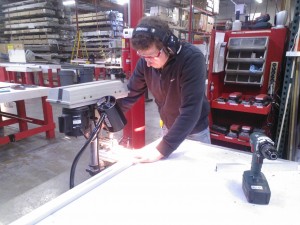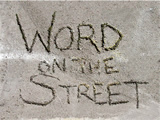What It’s Like to Visit Classic Exhibits
While many distributors have visited us over the years, to review projects, for one-on-one training, for Shared Knowledge University, it sometimes slips my mind that many of you haven’t been to our facility. So, if you have haven’t been to the Classic shop before, you’re probably wondering what it’s like. Well . . . it’s impressive and it’s weird. And when I say weird, I don’t mean “hellhole weird” with chains, dungeons, and pits with spikes . . . or Portland Weird (cause let’s face it, that’s a given), I mean the office layout and the entrances can sometimes be jarring to new visitors.
I’ll use the entrance as an example. Those of you who have been to our place know what I mean when I refer to the Little Red Door. If it sounds like you need a special knock or code word to get in, you don’t. But we do have a Little Red Door that lets you into our world. And when you open it, it’s clear what we do. We are a manufacturer. You walk right into Production. What we often refer to as our “Showroom.”
It’s always a kick for me to see the reaction of our customers when they enter the building. They are expecting to walk into a big beautiful showroom. And I would argue that they do. Just our version of a showroom.
 I’ve been thinking a lot about this recently because Mel and I have been looking at other buildings, buildings that would accommodate our growth over the next 5-10 years. We’ve seen some impressive facilities, with extensive offices, formal entrances, and flexible production floors. It’s hard not to drool. Mel has slipped on mine couple times already. It doesn’t mean we’re moving. Our landlord is really interested in keeping us and is hard at work on plans to expand our current site.
I’ve been thinking a lot about this recently because Mel and I have been looking at other buildings, buildings that would accommodate our growth over the next 5-10 years. We’ve seen some impressive facilities, with extensive offices, formal entrances, and flexible production floors. It’s hard not to drool. Mel has slipped on mine couple times already. It doesn’t mean we’re moving. Our landlord is really interested in keeping us and is hard at work on plans to expand our current site.
That said, allow me take you on a tour of Classic. I’ll include an informal video we shot a few years ago which will (hopefully) fill in some of the blanks. The shop has changed some, but you’ll see the overall organization. We’re proud of the Classic facility. It’s designed to be efficient and to maximize our flexible manufacturing capabilities.
For those who have been here, bear with me while I explain the layout. When we moved into our space over 10 years ago, our Ops Manager at the time had been a Process Engineer with Boeing in his previous life. And if you have ever seen the Boeing plant on TV or in person, then you know the process is laid out so that at one end of the building you start with raw materials, parts, and pieces. Then at the other end of the building a plane rolls out fully assembled.
Milling Department
Now I know we don’t build planes, but the overall thought process is the same. Nearly everything we build starts with one common denominator — aluminum extrusion. Whether it’s pop-up extrusion for a Quadro S, internal framing for a Euro LT or Intro panel, or exposed engineered extrusion for the Visionary Design Hybrid Exhibits. Extrusion is the starting point.
Video from November 2011
The metal gets cut, then either milled (CNC or by hand), then CNC bent (if necessary), then customized and assembled with connections, inserts, etc. Once done, the metal for hybrids moves all the way to the Set-up Area and then to the end of the line. The metal for Euro LT and Intro moves into the Panel Building Department where it is married with the CNC cut infill panels.
Wood Fabrication Department
Next you have the Wood Fabrication Department. This is where all soft materials, such as acrylics, wood, foam, etc. are CNC cut and assembled. Because everything is built off the CNC, it allows us to work right off the detail files. We cut parts and then the guys “assemble.” People are often amazed at our approach. We have two master cabinet makers on staff, but we have ten assemblers who are guided by the cabinet makers on how to assemble the parts that come off the CNC, including laminating, routing, and finishing.
Once counters, panels, custom components, and jigging for packaging or acrylic work is completed in Wood Fab, it is moved to the Set-up Area to meet up with any metal components.
Set-up Department
The next step is where we create the biggest difference between Classic and our competitors. The Set-up Area. It’s the place in the process where our true transparency shines through. The Set-up Department also acts as our ultimate quality control system. Everything is fully assembled, setup, and photographed regardless of size. Meaning, if you ordered an Intro 3-panel fabric table top, we set it up and take a photo of it just like we would with a complete Double Deck exhibit. And to prove it, we have three webcams in our Set-up Area that you can log into at any given time to check the progress of your booth. The Peek-a-Booth webcams have become a very familiar tool for many of our distributors.
So once the booth is setup, your Project Manager at Classic reviews the exhibit. At that point, they are your eyes and ears on our floor to ensure that the exhibit meets your preset expectations. If it does, they sign the order prior to tear-down and packaging.
Once the exhibit is torn down, it is packaged, most often in die-cut foam inserted into jigged cases or crates. The PM is then called out once more to review the packaged exhibit. The PM reviews the packaging, including anything you shipped to us to include such as monitors, graphics, etc. If it passes the review, they sign the order one final time.
At that point, our production process makes its only “non-linear” move. It makes a hard right turn into Shipping and into the waiting truck.
Now I understand that this is a really brief explanation and does not do justice to what our facility is like and how it functions. You don’t see the offices, the Rental Division, or Inventory Storage. So please don’t hesitate to schedule time to see us. We welcome client reviews, always a great time to come see the exhibit with your client and see our place. And since we stage everything, you should take advantage of that, rather than shipping it to your location for a client review.
We welcome onsite training as well, whether one-on-one or during Shared Knowledge University, our semi-annual training program. Plus SKU offers you the opportunity to be with distributors from other markets and share ideas during two days of comprehensive group training.
We hope your January is off to an amazing start. And hope to see you here in Portland sometime soon. We may be a little weird, but we are happy to share that weirdness with you. 🙂
See Classic’s Facebook page for daily photos and posts.
Kevin Carty
http://twitter.com/kevin_carty
http://www.linkedin.com/pub/kevin-carty/3/800/32a
[subscribe2]
Tags: Classic Exhibits, Milling, Production, Shop, Wood Fabrication































